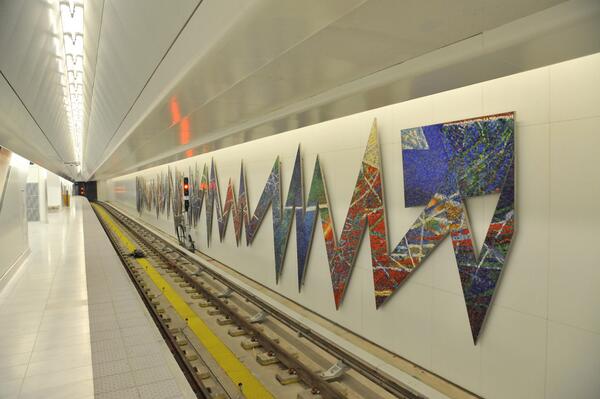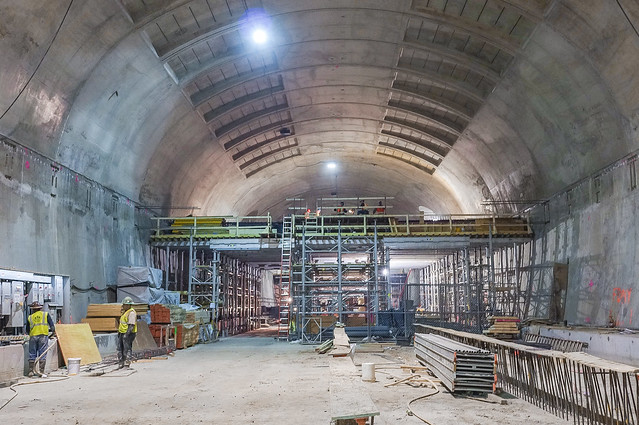
White marble surrounds the new Platform A at the WTC PATH Hub. (Photo via @PATHTrain)
Earlier this week, on the same day that the first permanent platform at PATH’s new World Trade Center hub opened, Santiago Calatrava visited NYU’s Rudin Center to discuss his work. While it’s hard these days for Calatrava to find projects to discuss that aren’t subject to lawsuits from disgruntled municipalities, the architect gave a presentation that included a discussion on the PATH Hub. I’m not sure why anyone keeps glorifying Calatrava when his projects tend to bilk taxpayers and suffer from exceedingly high costs, but as the live Tweet stream from the event shows, costs are certainly an acknowledged issue with Calatrava’s work.
Calatrava himself has been very reticent about discussing costs. According to one person at the NYU event, when asked about escalating price tags on another project, Calatrava grew very defensive, and he spoke vaguely about costs escalating due to outside forces. By all accounts, it was not a satisfying answer, but we’ve come to expect that from the person whose Lower Manhattan subway stop has seen costs nearly double from $2.3 billion to well over $4 billion.
Meanwhile, a few blocks south at the PATH Hub, the Port Authority celebrated the opening of Platform A. The new platform retains a part of the World Trade Center’s original slurry wall and will service the WTC-to-Hoboken route. It also features, per the Port Authority, “new lighting, speakers, illuminated signs, escalators and elevators.” It’s also noticeably filled with white marble. It’s so noticeable, in fact, that one New York tabloid finally woke up to the opulence of the design.
The Daily News today has issued a diatribe against the white marble. Their arguments are focused around safety and cleanliness, but a discussion of the costs creep up as well. Calling the thing “lavish, extravagant, foolish and, very surely, dangerous,” the News opined:
This is a disaster in the making, and the Port Authority must stop the madness. After the terror attack destroyed the twin towers, the PA set out to rebuild the PATH station below the World Trade Center using the billions of dollars in federal money sent to the city. No matter how strong the objections, the authority’s six New Jersey commissioners insisted that the new station must be the grandest ever built — even though it carries only 50,000 a day, less than half of the Long Island Railroad’s Penn Station passenger load.
To fulfill its grandiose vision, the PA retained the world’s most over-the-top architect, Santiago Calatrava, a man famous, or infamous, for designing super expensive, eye-catching, sculptural public buildings without regard to their functionality….Calatrava would be just the guy you don’t want designing a New York station. It has long been known that this PATH station was going to be overbuilt. What was not known until its unveiling was that Calatrava sold the PA on cladding top, sides and bottom in white Italian marble.
While the authority insists that the floors (wet or dry) meet or exceed all safety standards, everyone knows that water makes marble slippery. That’s why the owners of office towers with marble lobbies roll out mats on wet days. That why the Metropolitan Transportation Authority uses concrete, tile or granite in the floors of its 468 stations… At this point, the PA has put only one white marble platform into use. The station has three more platforms. Now is the time to switch to a different material for all of them, something more suitable for commuters running for trains, not that anybody does that much in New York.
The Daily News point almost misses the forest for the trees. Marble isn’t absurd only because it’ll get dirty and may be slippery; Italian marble is absurd because it carries with it an astronomical cost. It’s probably too late for the Port Authority to do anything about the materials used, and at this point, the costs aren’t going down. The train has long ago left that proverbial station, but at least someone is paying attention to this convoluted mess of a subway station rebuild.

 It’s time for another episode of everybody’s favorite subway podcast, “The Next Stop Is…” This week we’re talking about transit financing and we’re talking buses. In our chat, Eric and I talk about
It’s time for another episode of everybody’s favorite subway podcast, “The Next Stop Is…” This week we’re talking about transit financing and we’re talking buses. In our chat, Eric and I talk about 















 (Franklin Av)
(Franklin Av)